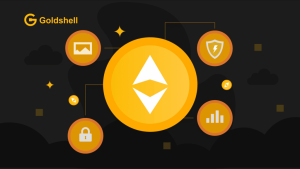
Ethereum (ETH)
| by research goldshell December 12, 2022 | REPORT |
66 | A Next-Generation Smart Contract and Decentralized Application Platform.
Launched in 2015, Ethereum builds on Bitcoin’s innovation, with some big differences.
Both let you use digital money without payment providers or banks. But Ethereum is programmable, so you can also build and deploy decentralized applications on its network.
Ethereum being programmable means that you can build apps that use the blockchain to store data or control what your app can do. This results in a general-purpose blockchain that can be programmed to do anything. As there is no limit to what Ethereum can do, it allows for great innovation to happen on the Ethereum network.
While Bitcoin is only a payment network, Ethereum is more like a marketplace of financial services, games, social networks, and other apps that respect your privacy and cannot censor you.
As of Nov 2022, Ethereum was the second-largest cryptocurrency by market capitalization. It has popularized the use of smart contracts, and thousands of teams are working on third-party solutions on the network for real business applications.
What can Ethereum do?
Banking for everyone: Not everyone has access to financial services. But all you need to access Ethereum and its lending, borrowing, and savings products is an internet connection.
A more private internet: You don’t need to provide all your personal details to use an Ethereum app. Ethereum is building an economy based on value, not surveillance.
A peer-to-peer network: Ethereum allows you to move money, or make agreements, directly with someone else. You don’t need to go through intermediary companies.
Censorship-resistant: No government or company has control over Ethereum. This decentralization makes it nearly impossible for anyone to stop you from receiving payments or using services on Ethereum.
Commerce guarantees: Customers have a secure, built-in guarantee that funds will only change hands if you provide what was agreed. Likewise, developers can have certainty that the rules won’t change them.
All products are composable: Since all apps are built on the same blockchain with a shared global state, they can build off each other (like legos). This allows for better products and experiences to be built all the time.
Why does ETH have value?
ETH’s valuable in different ways to different people.
For users of Ethereum, ETH is valuable because it lets you pay transaction fees.
Others see it as a digital store of value because the creation of new ETH slows down over time.
More recently, ETH has become valuable to users of financial apps on Ethereum. That’s because you can use ETH as collateral for crypto loans, or as a payment system.
Of course, many also see it as an investment, similar to Bitcoin or other cryptocurrencies.
What is Ethereum used for?
Ethereum has led to the creation of new products and services that can improve different areas of human lives.
Decentralized finance (DeFi): Explore an alternative financial system that is built without banks and is open to anyone.
Stablecoins: Stablecoins are cryptocurrencies designed to stay at a fixed value of a dollar.
Non-fungible tokens (NFTs): Non-fungible tokens represent ownership of unique items.
Decentralized autonomous organizations (DAOs): DAOs run without the need for coordination by a central entity.
Decentralized applications (dapps): Dapps are creating a new digital economy of peer-to-peer services.
Economics and supply distribution
Ethereum’s economics relies on a 3-phase model:
Phase 0 – ICO: an ICO was conducted in the first half of 2015 for 60 million ethers. The ICO was one of the first conducted and funds were collected in BTC.
Phase 1 – Proof of Work (current): reliance on the Ethash function: a function (relying on Keccak) that was designated to prevent ASIC participation owing to memory hardness. However, since then, blocks have become mostly mined by ASIC devices.
Phase 2 – Proof of Stake: in its final (Serenity) phase, Ethereum blocks will be validated through staking, and rewards will be distributed to validators.
Phase 0 was designated to bootstrap the network’s value, while phase 1 was designated to improve the supply distribution.
Since mining block rewards are now collected by centralized ASIC pools, phase 2’s rollout will lead to mining rewards being collected by ether-holders, which will act as validators.
This explains the ongoing debate about ProgPoW.The total supply of Ethereum is not capped, but as mining block rewards are fixed per block, the network’s inflation rate shall decay over time, in the (very) long-term approaching zero.
Project team
Ethereum’s development has been distributed with multiple teams and individuals involved in the development of Ethereum. The table below describes some of the most prominent early-stage contributors to the development of Ethereum.
| Individual | Position | Description |
|---|---|---|
| Amir Chetrit | Co-founder | Amir was the co-founder of Bitcoin Magazine in 2012. |
| Anthony Di Iorio | Co-founder | Anthony left the project in 2015 to work for the Toronto Stock Exchange as a digital asset officer. |
| Charles Hoskinson | Co-founder | Charles was the CEO of Ethereum before resigning in 2014 to create IOHK. |
| Gavin Wood | Co-founder | Gavin invented Solidity and wrote the Yellow Paper of Ethereum. First CTO of the Ethereum Foundation, he founded Parity Technologies in 2015. |
| Jeffrey Wilke | Co-founder | He started the first implementation of Ethereum using the Go the programming language in 2013. Despite leaving in 2017, he still is the top contributor to the go-Ethereum repo. |
| Joseph Lubin | Co-founder | Joseph co-founded Consensys in 2015 after leaving Ethereum in 2014. |
| Mihai Alisie | Co-founder | Mihai was the editor-in-chief of Bitcoin Magazine before working on Ethereum. |
| Stephan Tual | CCO of Ethereum | Stephan was the CCO of Ethereum and left in 2015. He is the founder of Atlas Neue and the CCO of Slock.it |
| Vitalik Buterin | Co-founder | Vitalik published articles for the Bitcoin Magazine before working on the Ethereum whitepaper in 2013. |
Appendix